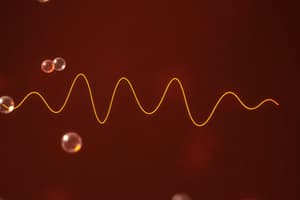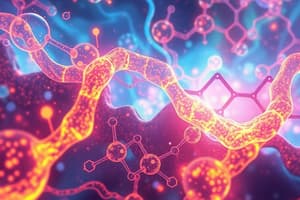Podcast
Questions and Answers
Which variable should be changed when investigating enzyme-controlled reactions?
Which variable should be changed when investigating enzyme-controlled reactions?
- Volume of the enzyme solution
- Only one variable at a time (correct)
- Temperature of the solutions
- Concentration of the substrate solution
What is the primary purpose of a negative control experiment in enzyme studies?
What is the primary purpose of a negative control experiment in enzyme studies?
- To demonstrate the effect of temperature on the enzyme
- To confirm that the enzyme remains active during the experiment
- To show that no reaction occurs without the substrate (correct)
- To illustrate how enzymes work
In an enzyme-controlled reaction, how is the initial rate of reaction determined?
In an enzyme-controlled reaction, how is the initial rate of reaction determined?
- By finding the maximum temperature reached during the reaction
- By calculating the average rate over the entire experiment
- By drawing a tangent at zero on the graph of product versus time (correct)
- By measuring the total volume of product produced
What molecules serve as the monomers of RNA?
What molecules serve as the monomers of RNA?
Why does the rate of enzyme-controlled reactions slow down over time?
Why does the rate of enzyme-controlled reactions slow down over time?
Which of the following best describes the units of measurement for the rate of an enzyme-controlled reaction?
Which of the following best describes the units of measurement for the rate of an enzyme-controlled reaction?
Which substance is catalyzed by the enzyme catalase?
Which substance is catalyzed by the enzyme catalase?
What component is NOT found in DNA nucleotides?
What component is NOT found in DNA nucleotides?
What is the main difference between the induced fit model and the lock and key model of enzyme action?
What is the main difference between the induced fit model and the lock and key model of enzyme action?
What effect does an increase in temperature have on enzyme activity up to the optimum temperature?
What effect does an increase in temperature have on enzyme activity up to the optimum temperature?
Which of the following statements about enzyme denaturation is true?
Which of the following statements about enzyme denaturation is true?
What happens to the enzyme activity after it reaches the optimum temperature?
What happens to the enzyme activity after it reaches the optimum temperature?
What characteristic do enzyme concentrations affect in a reaction?
What characteristic do enzyme concentrations affect in a reaction?
What is indicated by the downward trend beyond the optimum temperature in the enzyme activity graph?
What is indicated by the downward trend beyond the optimum temperature in the enzyme activity graph?
Which condition would cause the shape of an enzyme's active site to change irreversibly?
Which condition would cause the shape of an enzyme's active site to change irreversibly?
What occurs at the molecular level when the enzyme-substrate complex forms?
What occurs at the molecular level when the enzyme-substrate complex forms?
Flashcards
Enzyme-Controlled Reactions
Enzyme-Controlled Reactions
Biological reactions facilitated by enzymes that speed up the process by lowering activation energy.
Control Variables
Control Variables
Factors that must remain constant in an experiment to ensure that any observed change is due to the manipulated variable.
Gas Syringe
Gas Syringe
Tool used to measure oxygen production in an enzyme experiment, allowing for precise volume measurements over time.
Negative Control
Negative Control
Signup and view all the flashcards
Substrate
Substrate
Signup and view all the flashcards
Catalase
Catalase
Signup and view all the flashcards
Rate of Reaction
Rate of Reaction
Signup and view all the flashcards
Initial Rate
Initial Rate
Signup and view all the flashcards
Tangent
Tangent
Signup and view all the flashcards
Enzyme-Substrate Complex
Enzyme-Substrate Complex
Signup and view all the flashcards
Induced Fit Model
Induced Fit Model
Signup and view all the flashcards
Lock and Key Model
Lock and Key Model
Signup and view all the flashcards
Temperature
Temperature
Signup and view all the flashcards
Kinetic Energy
Kinetic Energy
Signup and view all the flashcards
Denaturation
Denaturation
Signup and view all the flashcards
pH
pH
Signup and view all the flashcards
Enzyme Concentration
Enzyme Concentration
Signup and view all the flashcards
Saturation
Saturation
Signup and view all the flashcards
DNA Nucleotide
DNA Nucleotide
Signup and view all the flashcards
RNA Nucleotide
RNA Nucleotide
Signup and view all the flashcards
Active Site
Active Site
Signup and view all the flashcards
Enzyme
Enzyme
Signup and view all the flashcards
Pentose Sugar
Pentose Sugar
Signup and view all the flashcards
Study Notes
Investigating Enzyme-Controlled Reactions
- Choose one variable to change at a time; control all other factors.
- Use a gas syringe to measure the volume of oxygen produced by catalase over time and repeat the experiment with different temperatures.
- Implement a negative control experiment to show no oxygen is produced without the active enzyme.
Control Variables
- Volume, concentration of substrate and enzyme solutions.
- Temperature and pH of solutions.
- Use water baths for maintaining constant temperature during experiments.
- Use buffer solutions to ensure consistent pH.
Calculating Rate of Reaction
- Rate of reaction is calculated using the gradient of a line on a graph.
- Initial rate is determined using a tangent drawn at the beginning of the curve.
- The gradient of the tangent shows the rate of reaction at a specific point.
- The initial rate will be highest because there are more enzyme-substrate interactions initially.
Explaining Rate of Reaction
- Rate of reaction slows as the substrate is used up, resulting in fewer collisions.
- The reaction stops when there is no substrate left.
### DNA and RNA Nucleotides
- Deoxyribonucleic acid (DNA) contains deoxyribose as the pentose sugar.
- Ribonucleic acid (RNA) contains ribose as the pentose sugar.
- A nitrogenous base and a phosphate group are also present in both DNA and RNA nucleotides.
Enzymes
- Proteins with a specific tertiary structure that act as biological catalysts.
- Active site: Complementary to a specific substrate, speeding up reactions by lowering activation energy.
- Location: Can be intracellular (inside cells) or extracellular (outside cells).
- Importance: Crucial for Determining cell and organism structure.
Induced Fit Model
- Replaced the Lock and Key Model, which proposed perfect enzyme-substrate complementarity.
- Active site flexibility: The shape of the active site changes slightly upon substrate binding to become fully complementary.
- Enzyme-Substrate Complex Formation: This complex puts stress on bonds or forms new bonds in the substrate, facilitating the reaction and lowering activation energy.
Temperature
- Kinetic Energy: Higher temperature leads to increased enzyme and substrate kinetic energy, resulting in more frequent and successful collisions and enzyme-substrate complex formation.
- Denaturation: Above the optimum temperature, enzymes become denatured. Excessive kinetic energy breaks hydrogen and ionic bonds between amino acid R groups, altering the active site shape and preventing substrate binding.
- Reversibility: Low temperature effects on enzyme activity are reversible, but high temperature denaturation is irreversible.
pH
- Denaturation: Enzymes are denatured both below and above the optimal pH.
- Ionic and Hydrogen Bond Disruption: H⁺ (acidic) or OH⁻ (alkali) ions interfere with hydrogen and ionic bonds between amino acid R groups, changing the active site shape.
Enzyme or Substrate Concentration
- Collision Frequency: Increasing either enzyme or substrate concentration increases the frequency of collisions between them, leading to more enzyme-substrate complexes.
- Saturation: Eventually, all available active sites are filled, or substrate concentration becomes limiting, leading to a plateau in the reaction rate.
- Graphs: The rate of reaction against temperature and pH is shown as bell-shaped curves, peaking at the optimum values. The curves demonstrate a maximum reaction rate that decreases as pH or temperature move away from the optimal levels. Denaturation is indicated by the downward trend in the curves beyond the optima.
- Diagram: A diagram illustrates the enzyme-substrate interaction process, showcasing the formation of the enzyme-substrate complex, the induced fit concept, and the release of products.
Studying That Suits You
Use AI to generate personalized quizzes and flashcards to suit your learning preferences.
Description
This quiz explores the principles and techniques used in enzyme-controlled reactions, including how to manipulate variables and measure reaction rates. It covers the importance of controlling factors like temperature and pH, as well as utilizing graphs to calculate reaction rates. Test your understanding of fundamental concepts in biochemistry.




